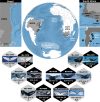Interchange of Southern Hemisphere humpback whales across the South Atlantic Ocean
- PMID: 36944685
- PMCID: PMC10030900
- DOI: 10.1038/s41598-023-31358-5
Interchange of Southern Hemisphere humpback whales across the South Atlantic Ocean
Abstract
The cosmopolitan distribution of humpback whales (Megaptera novaeangliae) is largely driven by migrations between winter low-latitude breeding grounds and summer high-latitude feeding grounds. Southern Hemisphere humpback whales faced intensive exploitation during the whaling eras and recently show evidence of population recovery. Gene flow and shared song indicate overlap between the western (A) and eastern (B1, B2) Breeding Stocks in the South Atlantic and Indian Oceans (C1). Here, we investigated photo-identification evidence of population interchange using images of individuals photographed during boat-based tourism and research in Brazil and South Africa from 1989 to 2022. Fluke images were uploaded to Happywhale, a global digital database for marine mammal identification. Six whales were recaptured between countries from 2002 to 2021 with resighting intervals ranging from 0.76 to 12.92 years. Four whales originally photographed off Abrolhos Bank, Brazil were photographed off the Western Cape, South Africa (feeding grounds for B2). Two whales originally photographed off the Western Cape were photographed off Brazil, one traveling to the Eastern Cape in the Southwestern Indian Ocean (a migration corridor for C1) before migrating westward to Brazil. These findings photographically confirm interchange of humpback whales across the South Atlantic and Indian Oceans and the importance of international collaboration to understand population boundaries.
© 2023. The Author(s).
Conflict of interest statement
The authors declare no competing interests.
Figures


References
-
- Riekkola L, et al. Application of a multi-disciplinary approach to reveal population structure and Southern Ocean feeding grounds of humpback whales. Ecol. Ind. 2018;89:455–465. doi: 10.1016/j.ecolind.2018.02.030. - DOI
-
- Conners MG, et al. Mismatches in scale between highly mobile marine megafauna and marine protected areas. Front. Mar. Sci. 2022 doi: 10.3389/fmars.2022.897104. - DOI
-
- Findlay K. A review of humpback whale catches by modern whaling operations in the Southern Hemisphere. Memoirs-Queensland Museum. 2001;47:411–420.
-
- Rocha RC, Clapham PJ, Ivashchenko YV. Emptying the oceans: A summary of industrial whaling catches in the 20th century. Mar. Fish. Rev. 2014;76:37–48. doi: 10.7755/MFR.76.4.3. - DOI
-
- Dawbin, W. (Los Angeles: University of California Press, 1966).
Publication types
MeSH terms
LinkOut - more resources
Full Text Sources

